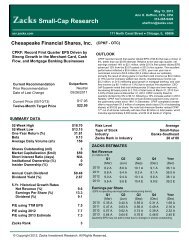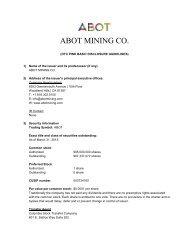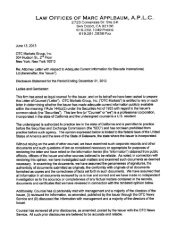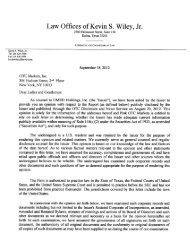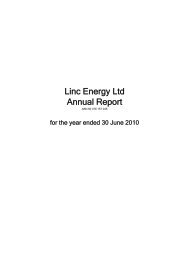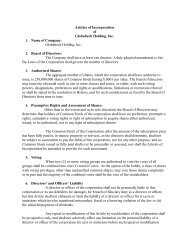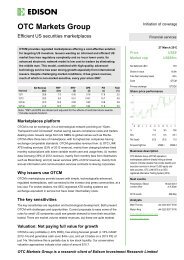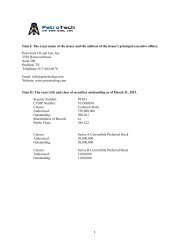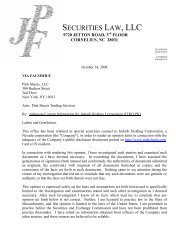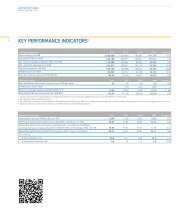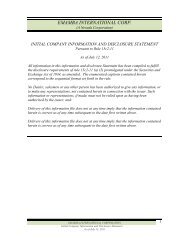2011 Annual Report - OTCIQ.com
2011 Annual Report - OTCIQ.com
2011 Annual Report - OTCIQ.com
Create successful ePaper yourself
Turn your PDF publications into a flip-book with our unique Google optimized e-Paper software.
Instruments <strong>com</strong>monly used are foreign currency forwards<br />
and swaps, as well as interest rate swaps, cross-currency swaps<br />
and interest rate options. In <strong>com</strong>modities, the instruments<br />
used include physically and financially settled forwards and<br />
options related to electricity, gas, coal, oil and emission rights.<br />
As part of conducting operations in <strong>com</strong>modities, derivatives<br />
are also acquired for proprietary trading purposes.<br />
IAS 39 sets requirements for the designation and documentation<br />
of hedging relationships, the hedging strategy, as well<br />
as ongoing retrospective and prospective measurement of<br />
effectiveness in order to qualify for hedge accounting. The Company<br />
does not exclude any <strong>com</strong>ponent of derivative gains<br />
and losses from the measurement of hedge effectiveness. Hedge<br />
accounting is considered to be appropriate if the assessment<br />
of hedge effectiveness indicates that the change in fair value<br />
of the designated hedging instrument is 80 to 125 percent<br />
effective at offsetting the change in fair value due to the hedged<br />
risk of the hedged item or transaction.<br />
For qualifying fair value hedges, the change in the fair value of<br />
the derivative and the change in the fair value of the hedged<br />
item that is due to the hedged risk(s) are recognized in in<strong>com</strong>e.<br />
If a derivative instrument qualifies as a cash flow hedge under<br />
IAS 39, the effective portion of the hedging instrument’s change<br />
in fair value is recognized in equity (as a <strong>com</strong>ponent of other<br />
<strong>com</strong>prehensive in<strong>com</strong>e) and reclassified into in<strong>com</strong>e in the<br />
period or periods during which the cash flows of the transaction<br />
being hedged affect in<strong>com</strong>e. The hedging result is reclassified<br />
into in<strong>com</strong>e imme diately if it be<strong>com</strong>es probable that the<br />
hedged underlying transaction will no longer occur. For hedging<br />
instruments used to establish cash flow hedges, the change<br />
in fair value of the ineffective portion is recognized immediately<br />
in the in<strong>com</strong>e statement to the extent required. To hedge<br />
the foreign currency risk arising from the Company’s net investment<br />
in foreign operations, derivative as well as non-derivative<br />
financial instruments are used. Gains or losses due to changes<br />
in fair value and from foreign currency trans lation are recognized<br />
separately within equity, as a <strong>com</strong>ponent of other <strong>com</strong>prehensive<br />
in<strong>com</strong>e, under currency translation adjustments.<br />
Changes in fair value of derivative instruments that must be<br />
recognized in in<strong>com</strong>e are presented as other operating in<strong>com</strong>e<br />
or expenses. Gains and losses from interest-rate derivatives<br />
are netted for each contract and included in interest in<strong>com</strong>e.<br />
CEO Letter<br />
E.ON Stock<br />
Combined Group Management <strong>Report</strong><br />
Consolidated Financial Statements<br />
Corporate Governance <strong>Report</strong><br />
Supervisory Board and Board of Management<br />
Tables and Explanations<br />
Gains and losses from derivative proprietary trading instruments<br />
are shown net as either revenues or cost of materials.<br />
Certain realized amounts are, if related to the sale of products<br />
or services, also included in sales or cost of materials.<br />
Unrealized gains and losses resulting from the initial measurement<br />
of derivative financial instruments at the inception of<br />
the contract are not recognized in in<strong>com</strong>e. They are instead<br />
deferred and recognized in in<strong>com</strong>e systematically over the<br />
term of the derivative. An exception to the accrual principle<br />
applies if unrealized gains and losses from the initial measurement<br />
are verified by quoted market prices, observable prices<br />
of other current market transactions or other observable data<br />
supporting the valuation technique. In this case the gains and<br />
losses are recognized in in<strong>com</strong>e.<br />
Contracts that are entered into for purposes of receiving or<br />
delivering non-financial items in accordance with E.ON’s anticipated<br />
procurement, sale or use requirements, and held as<br />
such, qualify as own-use contracts. They are not accounted for as<br />
derivative financial instruments at fair value in accordance with<br />
IAS 39, but as open transactions subject to the rules of IAS 37.<br />
IFRS 7, “Financial Instruments: Disclosures” (“IFRS 7”), requires<br />
<strong>com</strong>prehensive quantitative and qualitative disclosures<br />
about the extent of risks arising from financial instruments.<br />
Additional information on financial instruments is provided<br />
in Notes 30 and 31.<br />
Inventories<br />
The Company measures inventories at the lower of acquisition<br />
or production cost and net realizable value. The cost of raw<br />
materials, finished products and goods purchased for resale is<br />
determined based on the average cost method. In addition<br />
to production materials and wages, production costs include<br />
material and production overheads based on normal capacity.<br />
The costs of general administration are not capitalized. Inventory<br />
risks resulting from excess and obsolescence are provided<br />
for using appropriate valuation allowances, whereby inventories<br />
are written down to net realizable value.<br />
83



